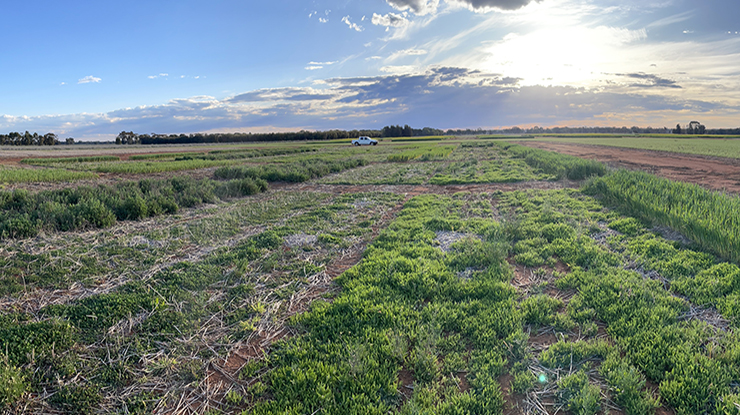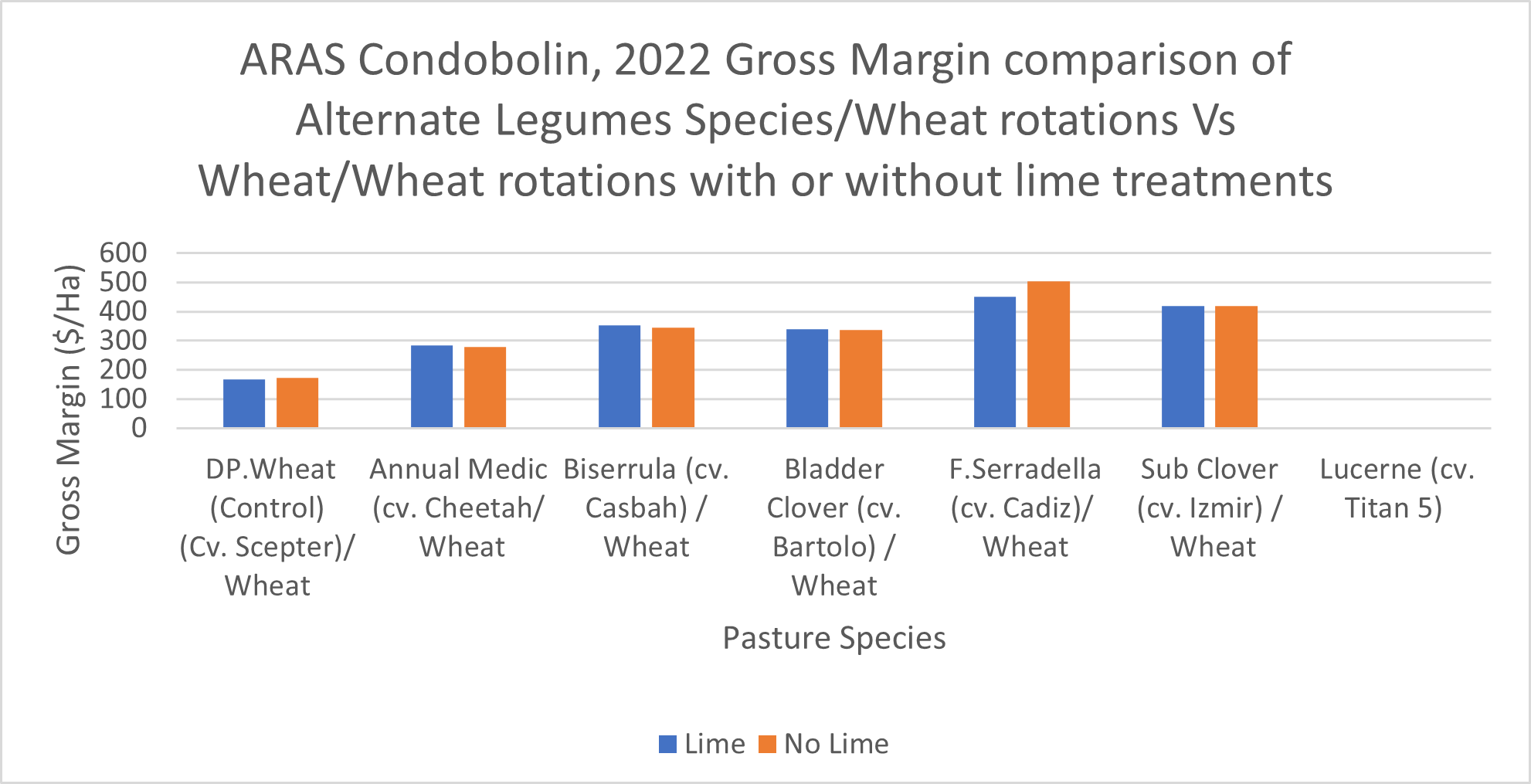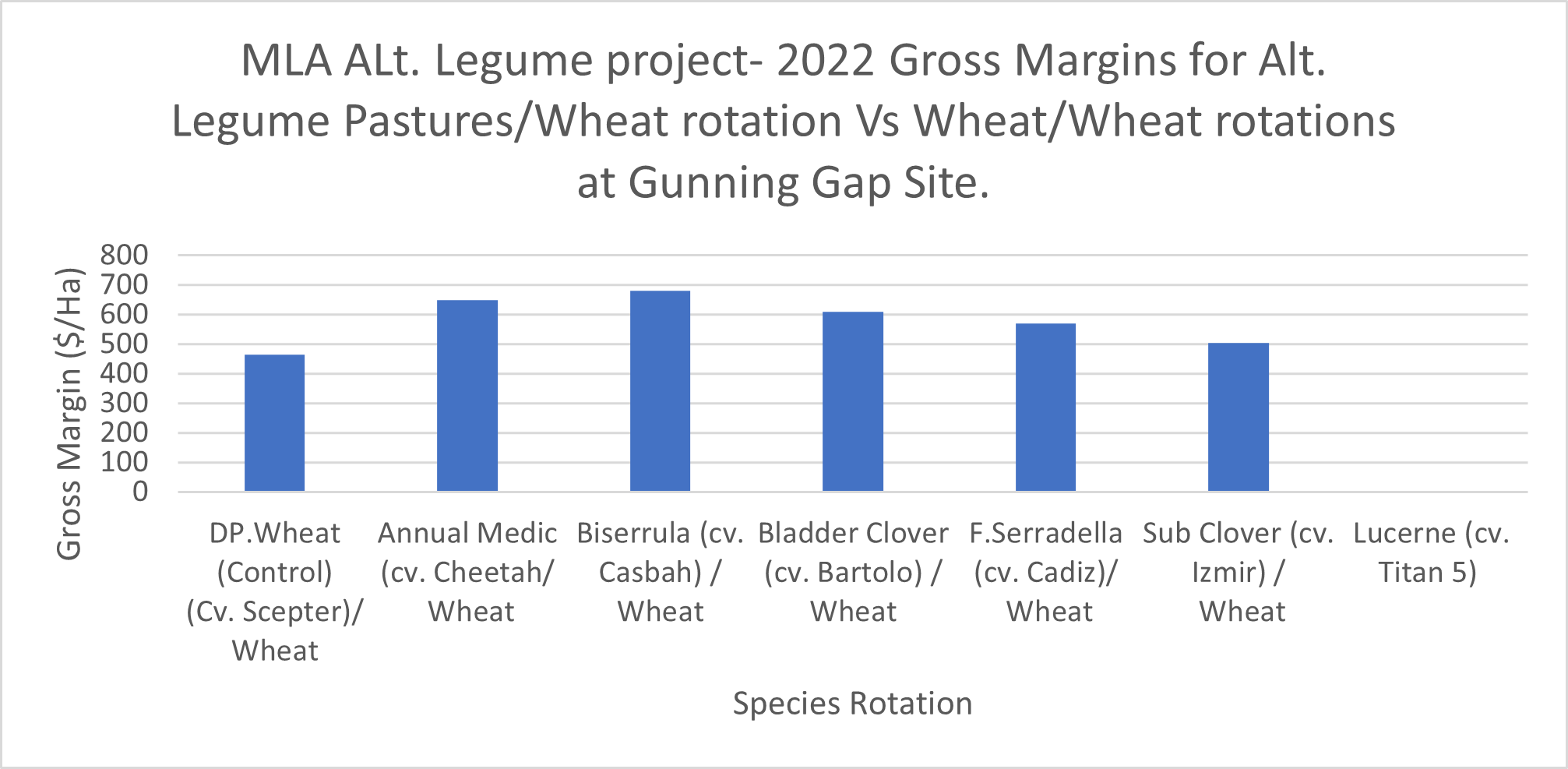Alternate hard seeded legumes in Central West NSW
25 March 2024

Comparison of 2022 gross margins of cropping year for winter wheat (grain) rotation sown to different hard seeded legumes treatments in 2nd year of establishment across two trial site areas in central west NSW.
The winter cereal rotation in this PDS project has presented the opportunity for both livestock and cropping enterprises to see how hard seeded legumes perform against other legume species, specifically against a traditional wheat on wheat winter cereal rotation from an early indicator profitability performance benchmark.
Whilst gross margins do not provide a true measure of profitability on their own, they illustrate a snapshot of variable costs and income, at a given point in time, for us to compare and build a cumulative picture of the performance of these forage base types. To ensure true alignment for business forecasting, each enterprise needs to add their business overhead costs onto these gross margins and input their variable costs figures.
During second year of the project, rotation was focused on growing a winter cereal grain crop. Within the growing season, it was found to be extremely challenging due to record higher than average rainfall received across the growing season at both Producer Demonstration Sites, culminating in flooding and water/flood damage impacting both locations throughout November and December 2022.
The main positive take home messages from the cereal phase grain crop in the rotation is that alternate hard seeded legumes produced a positive influence on gross margin outcomes across both trial sites. Following on from initial pasture establishment phase in year 1, this year’s trialling demonstrated that the incorporation of any legume, including hard seeded legumes, resulted in positive gross margins for wheat grain crop in rotation within the central west region. This may be explained by the legumes providing additional nutrition for utilisation and benefit of the wheat crop yield. However, the quantification of the exact nutritional influences and the economic impact these legume pastures provide sits outside the scope of this project. Further research is required for the low rainfall zone.
From the gross margins at the ARAS Condobolin site in Figure 1, we see that all legume pasture/wheat rotations (including all three hard seeded legumes) outperformed the winter cereal wheat on wheat rotation regardless of lime or no lime treatments during the second year following a legume pasture phase.
The French serradella (wheat rotation as shown in Table 1), had the highest gross margin of $504/ha in no lime treatments and $451.99/ha in limed treatments. This is reflective of higher yields being achieved in the second year of rotation whilst sown to wheat by the French Serradella pasture treatments occurred. Gross margins were based around grain being sold in March after harvest was completed in January 2023 at these sites.

Figure 1: Condobolin 2022, Gross margin ($/Ha) comparison of alternate legume species/wheat rotation grown in CW in comparison to wheat/wheat rotation. Analysis also shows the effect of lime treatment vs no lime treatment on Gross Margins.
|
Species Rotation |
DP.Wheat (Control) |
Annual Medic (cv. Cheetah/ |
Biserrula (cv. Casbah) / |
Bladder Clover (cv. Bartolo) / |
F.Serradella (cv. Cadiz)/ |
Sub Clover (cv. Izmir) / |
Lucerne (cv. Titan 5) |
|||||||
|
Treatment |
Lime |
No Lime |
Lime |
No Lime |
Lime |
No Lime |
Lime |
No Lime |
Lime |
No Lime |
Lime |
No Lime |
Lime |
No Lime |
|
Total Income |
652.34 |
659.1 |
774.02 |
767.26 |
845.00 |
834.86 |
831.48 |
828.1 |
946.40 |
1000.5 |
912.60 |
912.6 |
0 |
0 |
|
Total Variable Cost |
485.39 |
485.59 |
489.12 |
488.91 |
491.30 |
490.99 |
490.89 |
490.78 |
494.41 |
496.07 |
493.38 |
493.38 |
0 |
0 |
|
GM ($/Ha) |
166.95 |
173.51 |
284.90 |
278.35 |
353.70 |
343.87 |
340.59 |
337.32 |
451.99 |
504.41 |
419.22 |
419.22 |
0.00 |
0.00 |
Table 1: Gross Margin comparison of variable costs and income for 2022 wheat rotation 2nd year of Alternative legume in Central West NSW forage base options, following a pasture phase with 5 legume species.
Gunning Gap site:
Compared to the ARAS site, higher yields and quality indicators were recorded at the Gunning Gap site. During the 2022 growing season, exceptionally high rainfall was experienced, with the site receiving four times its average annual rainfall within the growing period. While high rainfall did impact the grain uality, the gross margins remained strong across all treatments.
The Biserrula (Cv. Casbah) on wheat rotation as shown in Figure 2 outperformed all other legume and cereal rotations at the Gunning Gap site. It had the highest gross margin per hectare returning at $679.44/Ha. All legume and cereal rotation options resulted in higher gross margins compared to the cereal (dual purpose)-to-cereal (grain crop) rotation across the two years as shown in Table 2. Within the legumes species, wheat (grain crop) rotation gross margins were stronger than a cereal (dual purpose) to Wheat (Grain) rotation by a range between $39.78 – $215.47/Ha. The lucerne treatment was not included in the cereal rotation as it was kept as a perennial pasture due flood effects on plant populations.

Figure 2: Gunning Gap MLA PDS Alternate legume forage base in Central West NSW, 2022 wheat grain crop 2nd year rotation gross margin results.
|
Species/Treatment |
1. DP.Wheat (Control) |
2. Lucerne (cv. Titan 5) |
3. Annual Medic (cv. Cheetah/ |
4. Biserrula (cv. Casbah) / |
5. Bladder Clover (cv. Bartolo) / |
6. F.Serradella (cv. Cadiz)/ |
7. Sub Clover (cv. Izmir) / |
|
Total Income |
906.30 |
0.00 |
1097.82 |
1128.60 |
1056.78 |
1015.74 |
947.34 |
|
Total Variable Cost |
442.33 |
0.00 |
448.21 |
449.16 |
446.95 |
445.69 |
443.59 |
|
GM ($/Ha) |
463.97 |
0.00 |
649.61 |
679.44 |
609.83 |
570.05 |
503.75 |
Table 2: Gunning Gap 2022 – Harvest Gross Margin comparison for Alternate legume species compared to Dual Purpose Wheat (Control).
- Note that lucerne treatments were kept as Lucerne stands in 2022 and not sown to DP Wheat due to flood response recovery.
This provides a strong basis for NSW producers in low rainfall zones to adopt hard seeded legumes into their cropping systems using pasture ley opportunities to maximise and lift profitability potential in operations. For mixed livestock and cropping businesses, these results validate the adoption and use of hard seeded legumes as a forage due to its beneficial impacts on paddock rotations and flexibility to be used for both grazing or cropping. Businesses can reduce the risk and achieve positive return on investment by implementing hard seeded legume pastures as they provide strategically more flexibility in our rotations to react to climate variability. We look forward to combining the grain crop gross margin results with the establishment year gross margins, as well as commencing third year pasture phases to look at cumulative rotation profitability at the end of this project.


